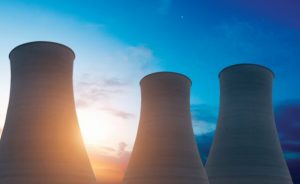Energy for the Masses: Raiders of the Lost Promise – The Holy Grail of Nuclear Fusion
All You Ever Wanted to Know about Stellarators and Tokamaks
 The vast amounts of energy released by splitting the atom has enabled scientists to produce both nuclear power and nuclear weapons, demonstrating that mankind’s amazing technical and creative ingenuity is perhaps matched only by its morbidly mad inclination towards self-destruction.
The vast amounts of energy released by splitting the atom has enabled scientists to produce both nuclear power and nuclear weapons, demonstrating that mankind’s amazing technical and creative ingenuity is perhaps matched only by its morbidly mad inclination towards self-destruction.
Just gaze at the stars to watch the nuclear fusion in action. The star at the centre of our own solar system, the sun, produces heat and light by fusing hydrogen atoms to produce helium. In fact, every second our sun – a rather puny star – produces more energy through fusion than humankind has managed to generate since the dawn of time.
Replicating this process – a reaction set in motion by extremely high temperatures – is the holy grail of nuclear physicists. Scientists the world over are searching for a commercially viable way to fuse atoms – getting atomic nuclei to collide and join to form a new nucleus. The energy thus released could be used to generate electricity. For years, research scientists have worked to better understand, control, and replicate nuclear fusion. However, experts within the nuclear industry wryly note that the technology remains elusive as ever and always seems some forty-odd years away from becoming commercially viable.
“Replicating this process – a reaction set in motion by extremely high temperatures – is the holy grail of nuclear physicists. Scientists the world over are searching for a commercially viable way to fuse atoms – getting atomic nuclei to collide and join to form a new nucleus.”
Existing nuclear power generation is based on nuclear fission whereby the nucleus of atoms is burst apart. The technology for splitting heavy atoms to produce nuclear power has been in use since the mid-20th century. The current generation of nuclear reactors work by splitting uranium atoms. This releases energy which is controlled and used as a source of heat to produce the steam that generates electricity. Nuclear fission provides about a tenth of the world’s electricity.
Nuclear fission has a number of disadvantages. For a start, the capital costs are huge: nuclear fuel is highly radioactive which necessitates an expensive safety and security infrastructure. The process also produces nuclear waste which must be somehow kept away from people for hundreds of thousands of years before it will have decayed.
Nuclear fusion could, conceivably, provide the answer to the world’s apparently insatiable demand for affordable power, generated with a negligible environmental impact.
Earthbound Sun
Massive gravitational forces create just the right conditions for fusion in the sun. These are hard to replicate on earth. The fuel, isotopes of hydrogen atoms, must be heated to extreme temperatures of around a 100 million degrees Celsius and then be kept dense enough, and confined long enough, to allow the nuclei to fuse.
The nucleus of an atom contains protons, which carry a positive charge. These nuclei strongly resist being brought close to each other. This electrostatic repulsion can be overcome by accelerating their movement to high speeds, forcing the nuclei close enough to achieve fusion. This process creates a heavier nucleus and generally releases more energy than it takes to force them to fuse.
The energy–releasing process can set in motion a self-sustaining reaction. This is the very process that has fuelled the sun for over four billion years. It will continue to do so for another four billion years – give or take. The advantages of nuclear fusion are legion: abundant fuel supplies; no carbon emissions; no radioactive waste; and a very high yield.
However, scientific understanding of nuclear fusion is still in its early stages. The most pressing practical problem with nuclear fusion is that extremely high levels of heat are required to fuse the nuclei together. The facilities needed for fusion are prohibitively expensive. Materials are yet to be developed that can withstand the extremely high heat necessary for a fusion reaction to take place. Large scale production would become much more feasible if cold fusion could be developed. This, however, has progressed no further than a theoretical possibility.
Stellarators and Tokamaks
Research into fusion is focused on the reaction between the nuclei of the two heavy forms of hydrogen – deuterium (D) and tritium (T) – in a hot gas plasma. Deuterium is found in seawater while tritium occurs only in trace quantities in the wild. However, it can be produced in a conventional nuclear reactor or bred in a fusion system from lithium. It is radioactive, but has a half-life of only around twelve years.
One of the main experimental approaches entails the use of strong magnetic fields to contain the hot D-T plasma at a few atmospheres of pressure while it is heated to fusion temperature. The most effective magnetic configuration is doughnut-shaped with the magnetic field forming a closed loop. Current systems include tokamaks and stellarators, experimental devices used to confine hot plasma in order to sustain a nuclear fusion reaction.
Soviet physicists designed the first tokamak in 1951. Since then, over 200 have been built, with more than 35 currently in operation. Research is continuing around the world, including at the Joint European Torus (JET) at Culham in the UK and the tokamak fusion test reactor (TFTR) at Princeton in the USA.
The cost and complexity of the work has fostered international collaboration. Project partners China, India, Japan, Russia, South Korea, the US, and the European Union are jointly working on the ITER (International Thermonuclear Experimental Reactor) – a $20 billion machine currently under construction in Cadarache, France. When finished, it will be the world’s largest tokamak. Nuclear projects are notorious for bursting through both budgets and timelines. Predictably, the cost for the ITER (Latin for journey) has already spiralled while the completion date has slipped back several years.
The aim of the 35-year project is to prove that fusion can produce useful energy to the point where a full-scale demo fusion reactor can be designed. If successful, the achievement will be comparable to the moment, over seventy years ago, when the first critical nuclear fission reactions were sustained in a Chicago laboratory that was part of the top secret Manhattan Project.
Stellarators are notoriously difficult to build. There have been a handful of attempts, but their completion rate is low. In the plasma community, stellarators are known as the black horse amongst nuclear fusion reactors. Originally designed by a researcher at Princeton University in 1951, the stellarator was too complex to build with the then-available materials which explains why the much more viable tokamak design became the standard for fusion research. The calculations required to ensure ultimate plasma containment and control in a stellarator have only become feasible with the advent of the computer age.
In 2014, the Max Planck Institute for Plasma Physics in Griefswald, Germany, completed the world’s first large-scale optimised stellarator at a cost of over $1 billion. The Wendelstein 7-X nuclear fusion machine was more than 15 years in the making. German engineers subjected the device to a full year of tests, before they were ready fire up the machine for its maiden trip.
The W7-X is claimed to be so efficient that its enormous magnetic field is able to contain the super-heated plasma for up to thirty minutes at a time. The stellarator is a massively complex structure: the containment vessel is twisted into a shape that forces the plasma into the centre of the reactor as it continuously encounters opposing magnetic fields along its entire path. The design aims to provide a more stable environment for plasma and thus offer a more promising route for nuclear fusion research.
Like ITER, the W7-X is a but stepping stone in the journey towards nuclear fusion. However, at present, sustainable, self-powering nuclear fusion still remains a distant prospect.
Fusion Alternatives
One of the main drawback of current fission reactor designs is their uranium fuel is enriched by the same technology that produces nuclear weapons. This leads to concerns about the proliferation of nuclear weapons. Scientists have been looking for ways to break this disconcerting link.
Thorium, an element named after the Norse god of thunder, may offer a fuel alternative for fission reactors. China and India are both keen to develop this technology as it may offer a number of advantages that are much easier to reap than nuclear fusion.
Although thorium is not fissile – i.e. it cannot be split – bombardment by neutrons can turn it into an isotope of uranium. This can then be burned in a conventional reactor along with enriched uranium or plutonium to supply the necessary neutrons. An attractive alternative is to turn the element into its fluoride and mix that with fluorides of beryllium and lithium.
This concoction brings the melting-point down from over 1,000 degrees C to 360 degrees C, making the mechanics of the fission process more manageable.
A seed of uranium or plutonium is needed to prod the neutrons to start the reaction, but once this is underway the process becomes entirely self-sustaining. At this stage, the seed material becomes superfluous and can be flushed out of the reactor while additional liquid thorium fluoride can be fed in as needed. Unlike light-water reactors which must be shut down for refuelling every 18 months, thorium reactors can run uninterrupted for years on end.
A major advantage of a liquid fluoride thorium reactor is that it works at atmospheric pressure. Unlike conventional reactors, that use cooling water under extremely high pressure, a thorium reactor does not need these elaborate systems in order to function. As a result, the reactor can do without steel pressure vessels and does not require a large concrete containment dome that protects the environment in case the cooling system fails leading to a release of radioactive steam.
Thorium reactors also produce significantly less nuclear waste. The amount is does produce is much less hazardous than the refuse light-water reactors. It also decays faster with radioactivity decreasing to safe levels in centuries rather than millennia.
In nature, thorium is about three to four times as abundant as uranium. India, which relies on imported uranium and fossil fuel, is endowed with abundant thorium reserves and plans to use these to fuel a new generation of nuclear reactors. Currently, a small thorium research reactor is already up and running.
China has put a large team of scientists and engineers to work on the development of thorium reactors. A first prototype thorium reactor is due for completion soon. The Indian and Chinese experimental thorium reactors use solid fuel but are set up to eventually process molten thorium fluoride. It is not yet clear how long it will take to develop commercial thorium reactors. However, most experts expect the first ones to become operational in the next decade – years, if not eons, before nuclear fusion reaches that stage.
Small Modular Reactors
In the early twenty-first century, the nuclear industry was looking forward to a nuclear renaissance: growing concerns about climate change was expected to turn the anti-nuclear tide and present a compelling case for revisiting the nuclear option. The trend in reactor design had been to develop ever bigger reactors, intended to supply large populations with base load electricity through a national high voltage transmission system. New Generation III reactors with a capacity of at least a gigawatt came onto the market. These designs featured passive safety mechanisms which are triggered without human intervention.
However, the nuclear renaissance failed to materialise. The global economic downturn that started in 2008 reduced demand for power and high capital deterred investors. The tsunami that flooded Japan’s Fukushima-Daiichi nuclear plant in 2011 led to major safety reviews across the nuclear estate. Germany, Switzerland, Belgium, and Spain decided to phase out nuclear altogether. However, China, Russia, India, and the United Arab Emirates remain firmly committed to nuclear new build programmes. Potential newcomers to nuclear energy include Turkey, Jordan, Kazakhstan, Egypt, and Vietnam.
Interestingly, the interest in small modular reactors (SMRs) – compact and relatively simple systems – has taken off. These mini-reactors have been used in nuclear submarines for decades. SMRs are now being adapted for terrestrial use by a desire to reduce capital costs and provide power away from large grid systems.
SMRs have compact architecture and use passive safety concepts. Their modular design means they can be series-produced in factories for ready onsite installation. SMRs require less fuel and produce less radioactive waste. They can be easily removed for decommissioning and need less cooling water and less transmission capacity than their giant counterparts. If designs can be standardised, cost benefits will accrue and SMRs could find applications around the globe.
In 1954, at the dawn of the nuclear era, Lewis Strauss, chairman of the US Atomic Energy Commission, famously said: “It is not too much to expect that our children will enjoy in their homes nuclear generated electrical energy too cheap to meter.”
Sadly, this prophesy was wildly off the mark. However, the development of nuclear fusion could eventually lead to readily available, clean, and low-cost electricity for all. Atomic power generation could yet live up to its promise.
By Penny Hitchin
You may have an interest in also reading…
BBE’s CEO & MD Victor van der Kwast: AI is Certainly Coming to Banking Sector — It’s All About Integration
BBE’s CEO and managing director Victor van der Kwast initiated an all-encompassing, digitally focused transformation journey in 2020. It has
World Economic Forum Calls for Resilient Dynamism
David Cameron, Angela Merkel and the prime ministers of Russia and Italy will address the World Economic Forum Annual Meeting,
From Croatia to Chile – The Luksic Family: From the World’s Driest Desert to the Forbes List
In Chile, everyone knows the Luksics and their remarkable story that started with Policarpo Luksic who left his native Croatia



















































































